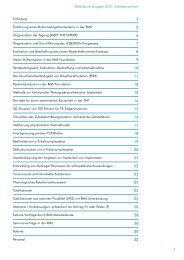RMS-Bericht 2012 - RMS Foundation
RMS-Bericht 2012 - RMS Foundation
RMS-Bericht 2012 - RMS Foundation
You also want an ePaper? Increase the reach of your titles
YUMPU automatically turns print PDFs into web optimized ePapers that Google loves.
<strong>RMS</strong> Report edition <strong>2012</strong> – Materials / Surfaces<br />
Künstliche Gelenkflüssigkeit für die Verschleisstestung<br />
Artificial synovia for the testing of materials for hip replacements<br />
Bei der Testung von Materialien für künstliche<br />
Gelenke besteht das Problem, dass die<br />
Zusammensetzungen der verwendeten Testflüssigkeiten<br />
stark variieren und nicht wirklich<br />
der realen Gelenkflüssigkeit entsprechen. Im<br />
Rahmen einer Diplomarbeit wurde daher die<br />
bestehende, auf Rinderserum (NCS) basierende<br />
Hüftsimulator-Testflüssigkeit (HiSi) verändert<br />
und der Gelenksflüssigkeit angeglichen. Die<br />
Viskosität wurde durch Zugabe von Hyaluronsäure<br />
(HA) erhöht, und mittels Ringerlösung<br />
(RS) wurde die Ionenkonzentration an die<br />
natürlichen Verhältnisse angepasst. Da die<br />
Zusammensetzung von NCS von Lot zu Lot<br />
variiert, wurde NCS durch die Rinderserumproteine<br />
Albumin (BSA) und Globulin (IgG)<br />
ersetzt und mit Phospholipiden (PL) ergänzt.<br />
Die tribologischen Eigenschaften der künstlichen<br />
Gelenkflüssigkeiten wurden anhand<br />
der Gleitpaarung mit Pins aus ultrahochmolekularem<br />
Polyethylen (UHMWPE) gegenüber<br />
CoCrMo getestet. Der Reibungskoeffizient<br />
wurde bei Geschwindigkeiten von 1 – 20 mm/s<br />
(lineare 10 mm Bewegung und 1 N Last) und<br />
der Abrieb auf dem OrthoPOD1 getestet.<br />
Erwartungsgemäss war die Reibung bei höheren<br />
Geschwindigkeiten kleiner, vor allem<br />
bei den hochviskosen Testflüssigkeiten mit<br />
HA. Durch den Ersatz des NCS mit den<br />
einzelnen Proteinen stieg die Reibung leicht<br />
an; auch die Zugabe der Phospholipide änderte<br />
nichts daran. Folglich muss ein Teil der<br />
zahlreichen weiteren Proteine im NCS gute<br />
Schmiereigenschaften aufweisen. Der Abrieb<br />
war im Vergleich zur HiSi durch die Zugabe<br />
von HA 20 % tiefer und mit HA + RS wieder<br />
etwa gleich. Durch die Verwendung von BSA<br />
sank der Abrieb um 40 %, während bei den<br />
IgG-haltigen Testflüssigkeiten der Abrieb leicht<br />
höher ausfiel.<br />
Die herkömmliche Testflüssigkeit kann somit<br />
durch eine realistischere künstliche Gelenkflüssigkeit<br />
bestehend aus HA, RS, BSA, IgG und<br />
PL ersetzt werden. Dies würde dank Standardprodukten<br />
eine erhöhte Reproduzierbarkeit bei<br />
etwa gleichbleibenden Kosten gewährleisten.<br />
1 Details im <strong>Bericht</strong> «Verschleissreduktion durch Kavitäten»,<br />
Seite 12.<br />
The test fluids for the tribological testing of<br />
materials for artificial joints vary strongly and<br />
are quite different from the real synovial fluid.<br />
Therefore an artificial synovial test fluid was<br />
developed in a step by step approach starting<br />
with the existing test fluid for the hip simulator<br />
(HiSi) based on newborn calf serum (NCS)<br />
based. First, hyaluronic acid (HA) was added<br />
in order to increase the viscosity. With respect<br />
to the ion level in the body, ringer solution (RS)<br />
was used instead of deionized water. Because<br />
the proteins in serum vary from lot to lot,<br />
the pure proteins albumin (BSA, bovine) and<br />
immunoglobulin G (IgG) were added instead<br />
of the NCS. Finally phospholipids (PL) were<br />
added since they are known as boundary<br />
lubricants.<br />
The viscosity of the test fluids and their tribological<br />
properties lubricating γ-irradiated<br />
ultra-high-molecular-weight polyethylene<br />
(UHMWPE) pins on CoCrMo discs were tested.<br />
The friction coefficient was determined on a<br />
reciprocal tribometer applying different sliding<br />
speeds ranging from 1 to 20 mm/s (10 mm<br />
@ 1 N load). The wear was investigated on<br />
an OrthoPOD device1 .<br />
The higher the sliding speed, the lower was the<br />
resulting friction, especially with the test fluids<br />
containing the highly-viscous HA. Substituting<br />
the NCS by the single proteins led to an increase<br />
of the friction forces, surprisingly also in the<br />
presence of the phospholipids. Thus some of<br />
the additional proteins in NCS must exhibit excellent<br />
lubrication properties. Compared to the<br />
HiSi, the wear<br />
was 20 % lower<br />
adding HA<br />
but about the<br />
same adding<br />
salts (RS) to the<br />
solution. Using<br />
albumin only<br />
led to a drop<br />
of the wear by<br />
40 % while in<br />
the presence<br />
of the globulin<br />
the wear was<br />
slightly higher.<br />
In this work it<br />
was shown that<br />
the existing test fluids can be replaced by more<br />
realistic synovial-like test fluids consisting of<br />
HA, RS, BSA, IgG and PL. Thanks to standardized<br />
products this would allow at the same<br />
costs a higher reproducibility and to compare<br />
the results of different laboratories.<br />
1 see report «Wear reduction due to cavities», page 12.<br />
R. Heuberger<br />
E. Bortel<br />
J. Krieg<br />
J. Sague<br />
Abbildung:<br />
Reibungskoeffizient von<br />
UHMWPE Pins vs. CoCrMo-<br />
Scheiben in verschiedenen<br />
Testflüssigkeiten.<br />
Figure:<br />
Friction coefficient of<br />
UHMWPE pins vs. CoCrMo<br />
discs in different test fluids.<br />
13





